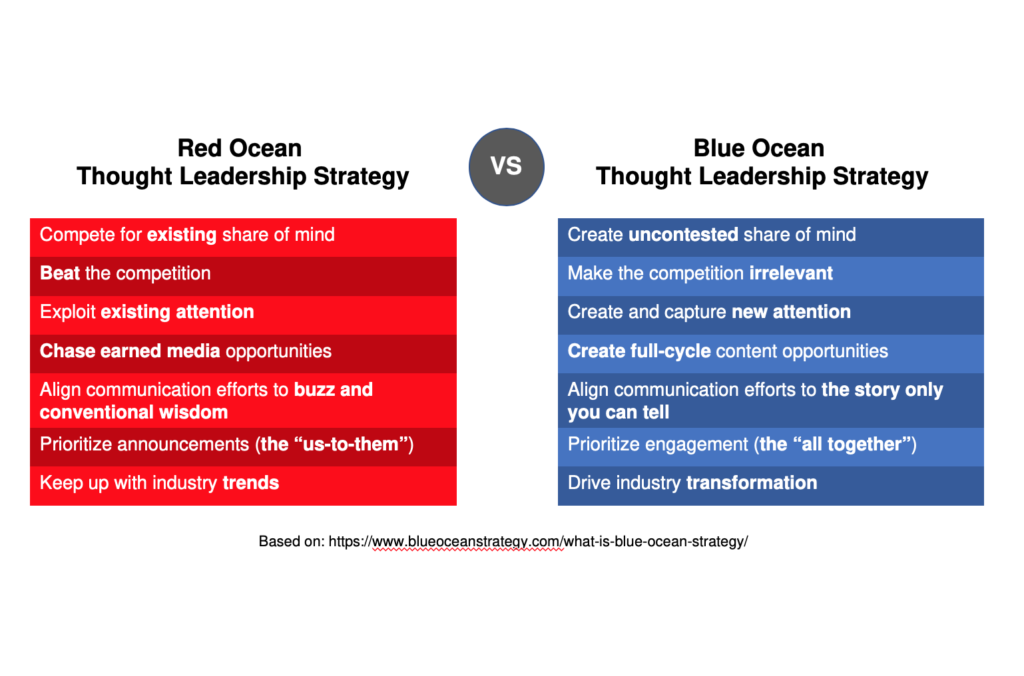Whispering into the wind won’t do much to help you get your message heard.
Many thought leadership strategies seem to ignore such basic common sense. They pursue overly broad topics where everyone has a point of view, such as blockchain or AI, and prioritize overcrowded channels to the exclusion of all else, such as earned media or Twitter, which provide only an opportunity to say very little while many others are also communicating in the same time and place.
As a result they miss the opportunity to go deeper and tell the story that only they can tell, to tell it in full, or to direct it intentionally to the right audiences.
I was drawn to reflect on this phenomenon recently by rereading Kim and Mauborgne’s Blue Ocean Strategy. While their focus is on product strategy, the parallels to thought leadership can be instructive.
In simplest terms, a red ocean is a crowded, well-known market where products are commodities. The waters are clouded by the blood of competitors in a feeding frenzy. A blue ocean is the wider, deeper, unexplored market space created through category innovation. When Apple entered the mobile phone industry, for example, it didn’t create a nicer or cheaper flipphone. It redefined mobility entirely with the iPhone.
How does this apply to thought leadership? A blue ocean thought leadership strategy will focus on seven things.

Creating uncontested share of mind: You don’t have to be present in the topics that everyone else is talking about, at least not from a thought leadership perspective. Offering clients and prospects an educational piece on a particular trend (again, such as blockchain or AI) can have instructional value when it comes from you as a trusted voice. Still, it does not serve the purpose of establishing a thought leading position. So instead, you can create uncontested share of mind by creating an entirely new topic, or by creating a substantially new way of looking at an existing topic…new ideas or a new voice or simply a surprisingly new angle can move you to much clearer space.
Making competitor voices irrelevant: Let your competitors be relevant in the areas that best and most specifically differentiate them. Do the same yourself. That’s where you will find your blue ocean thought leadership. You can best come to an understanding of this through careful analysis of your competitors’ content. What can you infer about their strategy? What are they saying and how? Then do something differently, in a way that aligns to your very specific commercial goals while at the same time strongly standing out in a unique voice.
Creating and capturing new attention: When people follow a specific topic or area of innovation, they have many sources of information already. In parallel, they are likely following many other topics. Their attention is crowded. A passing quote can create some awareness, but honestly ask yourself: how many times have you read an expert quote in a media source or blog and then actually taken the steps to research that expert thinking in more depth? Not to discount the possible cumulative impact of seeing such quotes again and again, but when you deploy blue ocean thought leadership, you create a destination for the “then what?” Frequent publication and interaction, even to the level of creating your own branded journalism, creates new spaces of attention.
Creating full-cycle content opportunities: According to Muck Rack, there are now more than 6 PR pros for every journalist, the reddest of red oceans for communicators. In fact, each communication channel suffers from several disadvantages and offers its own specific crowded market constraints. But the good news is that they tend to compensate for each other. Using owned media such as your own online presences compensates for the shallowness and speed of social media and the inherent forgettability of almost all earned traditional media. Conferences and speaking opportunities offset the one-way nature of your owned media. By mixing these channels in your own way, with the content that you yourself create and publish as the wind in your sails, you head into bluer oceans.
Aligning communication efforts to the stories only you can tell: This element of blue ocean thought leadership calls for a fair degree of introspection. Companies seeking a thought leading position need to understand what justifies such a position in a very detailed way. How have you changed the product or service landscape in your industry? How exactly have your executives and top subject matter experts led? These are tough questions to answer; they often benefit from an objective third-party view to draw clear lines between self-talk, justifiable aspiration, and legitimately stable positions of leadership. The answers you find to them will become the source for stories and points of view grounded in your own specific capabilities.
Prioritizing engagement over announcement: There’s a difference between simply saying something and effecting change. Announcing a new product or service or a strategic senior hire can provide evidence for your industry leadership, but such announcements must sit underneath a broader strategy of thought leadership creation in order to work. They must be accompanied by more substantive content and by direct engagement efforts to deliver content and messages to target audiences. You can’t be a disconnected we speaking to an indistinct them. You have to go “you to you” to win. Think of the parallel to a political campaign. After a candidate announces a run, they get out into the world and have conversations. They engage with stakeholders in social channels. And they maintain a steady flow of messaging to connect their goal (an election win) to their audiences’ actions (such as supporting, donating, and voting). Being recognized as the leader in a particular domain requires the same level of engagement and campaigning.
Driving industry transformation: As I have said in a previous blog post, true thought leadership puts the stress on the “leadership” dimension of the concept. Pieces that summarize recent trends do not meet that criterion. In the crowded space of points of view on reasonably well-known topics in your industry, you have to lay out a vision for how the knowledge and practices must evolve. This vision, of course, should tie back to concrete practices within your organization so that you can demonstrate proof and believability. With that deep experiential authenticity, you stay with in a blue ocean of what only you can describe. And you champion the advancement of your industry as a result.
While none of these is an either-or choice, they do suggest vital parameters for creating and amplifying a true voice. Few thought leaders have the full luxury of avoiding red oceans entirely, but those who dwell there risk having their messages drowned out and forgotten.
So how red is your ocean? And how blue would you like it to be?




